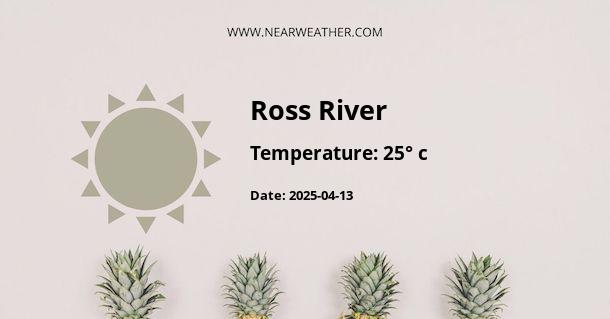Ross River, Australia: Climate and Weather Year Round
Ross River, located in Australia, experiences a unique climate characterized by its hot and dry summers and mild winters. As one of the major cities in northern Queensland, Ross River is known for its stunning landscapes, rich wildlife, and diverse climate. In this article, we will delve into the details of Ross River's climate and weather throughout the year, providing you with a comprehensive understanding of what to expect when visiting or residing in this region.
Climate Overview
Ross River falls within the tropical savanna climate zone, which is influenced by its proximity to the coast and its location in the northern region of Australia. This climate is characterized by distinct wet and dry seasons, with relatively high temperatures year-round.
The city experiences a wet season from November to April, characterized by heavy rainfall and high humidity. The dry season, on the other hand, extends from May to October and is characterized by lower humidity levels and minimal rainfall. These seasonal variations significantly impact the overall climate of Ross River.
Temperature
Ross River experiences hot and humid temperatures throughout the year, with relatively small variations between seasons. The average daily temperature in Ross River ranges from 25°C to 32°C (77°F to 90°F) during the wet season and 15°C to 28°C (59°F to 82°F) during the dry season.
During the summer months of December to February, temperatures can soar, with occasional heatwaves reaching over 40°C (104°F). It is essential to stay hydrated and seek shade during these extreme temperature periods.
In contrast, the winter months of June to August see milder temperatures, with average daily highs ranging from 20°C to 28°C (68°F to 82°F) and cooler evenings with temperatures dropping to around 10°C to 15°C (50°F to 59°F).
Rainfall
Ross River experiences a distinct wet and dry season, which greatly influences the rainfall patterns throughout the year. The wet season, from November to April, sees the majority of the city's annual rainfall, accounting for approximately 70-80% of the total precipitation.
During the wet season, Ross River receives an average of 1,000 to 1,200 mm (39 to 47 inches) of rainfall, with January and February being the wettest months. Heavy downpours and occasional thunderstorms are common during this period, contributing to the lush vegetation and vibrant ecosystem of the region.
On the other hand, the dry season, from May to October, experiences significantly less rainfall, with an average of 20 to 60 mm (0.8 to 2.4 inches) per month. This period is characterized by clear skies, minimal cloud cover, and low humidity levels.
Sunshine Hours
Ross River enjoys abundant sunshine throughout the year, with an average of approximately 8 to 9 hours of sunshine per day. The dry season, particularly June to August, offers the highest number of sunshine hours, making it an ideal time for outdoor activities and exploring the city's natural beauty.
Wind
Wind patterns in Ross River are influenced by the region's proximity to the coastline and the surrounding land formations. The prevailing winds in the area come from the southeast during the summer months and shift to the northeast during the winter months.
These winds generally remain light to moderate, with average speeds ranging from 10 to 20 km/h (6 to 12 mph). However, it is worth noting that occasional tropical cyclones may bring strong gusts and heavy winds to the region, particularly during the wet season.
Clothing and Travel Tips
When visiting or residing in Ross River, it is essential to consider the climate and weather conditions to ensure your comfort and safety. Here are some clothing and travel tips to keep in mind:
- During the wet season, pack lightweight and breathable clothing, as well as a waterproof jacket or umbrella, to protect yourself from the heavy rainfall.
- In the dry season, opt for light and comfortable attire, as temperatures can still be quite warm during the day. Don't forget to bring a light sweater or jacket for cooler evenings.
- Apply sunscreen and wear a hat to protect yourself from the strong Australian sun. Additionally, stay hydrated and drink plenty of water, especially during the hot summer months.
- If planning outdoor activities, check the weather forecast and be aware of any potential tropical cyclone warnings during the wet season. Always follow safety guidelines and seek shelter if necessary.
Conclusion
Ross River, Australia, offers a unique climate with its hot and dry summers, mild winters, and distinct wet and dry seasons. The city experiences high temperatures year-round, with the wet season bringing heavy rainfall and high humidity. The dry season offers clear skies, lower humidity, and minimal rainfall.
Whether you plan to visit Ross River for its natural wonders or reside in this vibrant city, understanding the climate and weather patterns will help you make the most of your experience. Remember to pack appropriately and take necessary precautions to ensure your comfort and safety throughout your stay in Ross River.
A - Ross River's Latitude is -19.316669 & Longitude is 146.733337.
A - Weather in Ross River is 25° today.
A - Climate Conditions in Ross River shows broken clouds today.
A - Humidity in Ross River is 78% today.
A - Wind speed in Ross River is 16.67 km/h, flowing at 180° wind direction. today.
